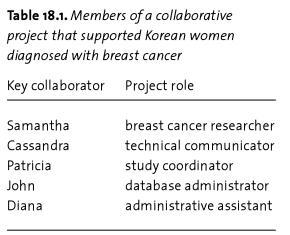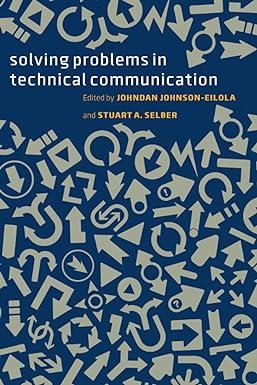Imagine that you have a job at a corporation where most employees work in cubicles while managers
Question:
Imagine that you have a job at a corporation where most employees work in cubicles while managers work in centrally located offices. Because most of the corporation's work is accomplished through shortand long-term group projects, meetings frequently take place either in conference rooms or at small tables in managers' offices. In addition, less formal interactions occur in a break room where coffee and bottled water are readily available. A task force has recently circulated a proposal that would allow the majority of employees a choice to telecommute up to 6o% of the time-that is, to work on computers in remote locations up to three days a week. Employees who favor the proposal believe that the time saved from commuting will increase productivity, generate goodwill, and decrease the carbon footprint from driving to work. Employees who oppose the proposal believe that the decrease in face-to-face contact will decrease the productivity of collaborative work. Your supervisor has asked you to assess the claims of the proposal and its opposition. What aspects of collaboration might be affected by the change? Write a short report that systematically explains the impact of telecommuting on cognition and learning, small-group processes, and technology. Refer explicitly either to this chapter's heuristic or to the heuristic you created in response to question 6. Frame your assessment as an argument that addresses each perspective and then recommends that the corporation either adopt or reject the proposal.
Data From Question 6:
Chapter's Opening Scenario:
Cassandra worked on grant-funded research projects at a health-care organization with scientists, project managers, information technology personnel, and administrative assistants. After a major project was funded, she joined a five-member group. Each member brought a different skill set and therefore assumed a different project role with different responsibilities.
The project's primary goal was to provide peer support to Korean women recently diagnosed with breast cancer by matching them with other women who had survived breast cancer. These women, working as volunteers, provided emotional support, information about breast cancer diagnosis and treatments, and help locating resources such as child care during medical appointments. Under the direction of the grant's principle investigator, Dr. Samantha Smith, the project group planned to develop culturally appropriate and bilingual (English/Korean) patient recruitment brochures, informational sheets about breast cancer, and in-take and tracking forms.
When Cassandra and Samantha learned that the project had been funded, they were both excited. As a well-known breast cancer researcher, Samantha was the subject-matter expert, while Cassandra was her technical editor. In the proposal, Samantha had specifically named Cassandra as the technical communicator, and three additional staff members: a study coordinator, a database administrator, and an administrative assistant (see table 18.1). Thirty volunteer breast cancer survivors would also be recruited to provide peer support, and a minimum of 300 patients would be enrolled during the two-year project.
Table 18.1:

Cassandra and Samantha had previously written several proposals to fund other breast cancer projects and had also collaborated on several final reports about these projects with John, the database administrator. Diana routinely provided administrative support to all staff, so Cassandra, John, and Diana had already established strong working relationships together.
The study coordinator, however, would be a new hire. This person would recruit and train the volunteer breast cancer survivors, enroll new patients, and serve as liaison between study participants and staff. She or he would need to develop strong relationships with both patients and project staff to help ensure that the staff could develop effective materials. The group hired Patricia, a bilingual (English/Korean) breast cancer survivor for the position. She brought the perspective of someone who had not only survived breast cancer but also was intimately familiar with the target culture.
Shortly after Patricia was hired, the group met in the conference room to discuss each person's role and to draft a long-term work plan. Samantha would oversee all aspects ofthe project; all staff would report directly to her. On the conference-room whiteboard, Diana began listing the project's major tasks and the person(s) responsible. The group would hold biweekly meetings, she explained, while individuals would also interact in the following smaller groups to help make the project more manageable:
• Cassandra, Patricia, and Samantha would jointly create the project recruitment materials.
• Samantha and Patricia would compose draft documents, which Cassandra would revise and edit.
• After recruitment was completed, John would create a patient-tracking database, and Diana would enter new patient information into the system as well as regularly update patient records.
During the biweekly meetings, each small group would report its progress to the group as a whole. The biweekly meetings would allow each group to gain a broader perspective on its work from the other group members. During these meetings, Samantha would encourage each person to offer substantive suggestions and feedback on all aspects ofthe project.
Samantha then addressed the software tools needed to accomplish each task. Creating some of the materials-such as the patient recruitment brochures-would require using publishing design software. Cassandra was taking a class for just this purpose. John would use the database management system that he routinely used for other projects to create data-entry screens for Diana. John would also train Diana to use the database management system.
The staff members worked in the office during regular business hours and were available for in-person or over-the-phone collaboration. Samantha, on the other hand, saw patients at her clinic several miles away three times a week. The group decided e-mail would be the best method for contacting her.
As the group discussed the project's goals, each individual's tasks and responsibilities, the available settings, and the required tools, Cassandra realized that her relationships with each of her coworkers and with Samantha in particular would change. Working with each person individually would require adjustments in communication styles. John, for example, seemed to prefer direct, businesslike interactions. Samantha, on the other hand, had previously assumed a personal style. However, Cassandra knew that Samantha now needed to assume the role of "boss," moving beyond their personal relationship and building working relationships with the other members of the group. All group members would need to make adjustments to be effective collaborators on this project.
As Cassandra's situation illustrates, many factors influence the ways in which technical communicators must approach and plan collaborative interactions with their group members. Gaining a more in-depth understanding of her situation will help you learn to work more effectively as a technical communicator on group-based projects. This chapter begins with a discussion of what collaboration is and what it is not, exploring the ways it affects technical communication practices. Next, a literature review summarizes critical research about factors that influence collaboration. Then, a heuristic provides ways to apply that research to your own collaborative projects. An extended example follows the heuristic, demonstrating the ways in which Cassandra applied it to her own situation.
Step by Step Answer:

Solving Problems In Technical Communication
ISBN: 9780226924076
1st Edition
Authors: Johndan Johnson-Eilola, Stuart A. Selber





